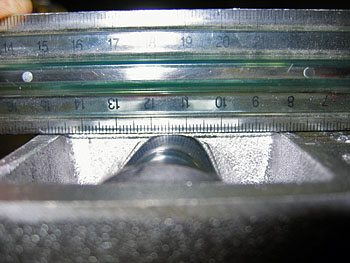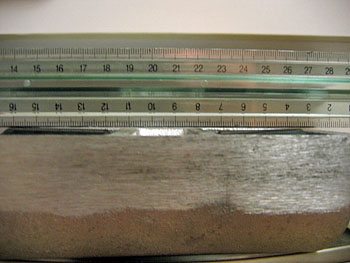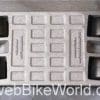I’ve come across several products recently that were designed to help owners move their motorcycles into tight spots in the garage or other storage spaces.
These devices may be especially useful for owners of big, long, heavy cruisers.
It’s hard enough to do the old back-and-forth shuffle while trying to get a short wheelbase sportbike up close against a wall — can you imaging trying to do the same with a monster like the Triumph Rocket III?
The TailSwinger motorcycle storage stand is a recent design. It fits under the rear wheel of a motorcycle, allowing the seated owner to move the bike back and forth to get it close to a wall or into a tight storage spot.
I’ll confess that I’ve never had much trouble backing my bike up against a wall or squeezing it into a tight parking spot, although my uncommonly oversized two-car garage makes it all seem very easy.
I assumed that the TailSwinger was made from plastic, but the 2.5 kg (5.5 lb.) device is actually a metal casting.
I’m not sure if the metal is aluminum — I don’t think it is — but it’s definitely a solid hunk.
Cyoma, the company that manufactures the TailSwinger, is probably concerned about liability, and thus made the stand 10 times heftier than is really necessary.
Cyoma claims that the TailSwinger will support up to 800 lbs., and I believe it.
The casting is about 12 mm thick (~.5 inch) in the middle, and there are four wheels underneath, each about 32 mm (1.25″) in diameter. It measures 15.5 cm across (6-1/8″) and 30 cm long (11-7/8″).
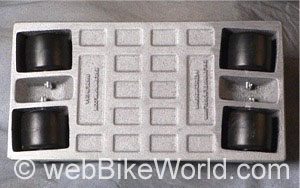

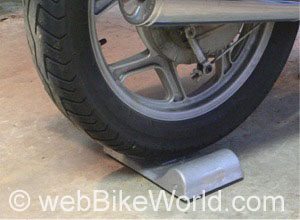
How It Works
Each wheel rotates on an axle that uses the casting as its bearing housing. The surface of the TailSwinger is as-cast, which probably gives the motorcycle tire some extra grip.
The four wheels are set at an angle; each pair is slightly offset to allow the TailSwinger to rotate left or right in a wide arc.
The instructions call for riding the motorcycle’s rear tire (and only the rear tire) up on to the “pocket” between the wheels of the device.
The videos on the Cyoma website show various owners sitting on their bikes and moving them back and forth while using the product.
I hadn’t considered that those owners might all have long legs, but I, unfortunately, do not.
My inseam is relatively short, and when I’m sitting on my motorcycle, my toes just barely touch the ground.
The extra 3/4″ height of the bike on the TailSwinger makes it impossible for me to push the bike around like the owners in the video.
I just don’t have enough leverage to overcome the initial resistance of the TailSwinger’s wheels with the weight of the motorcycle upon it. So if you have a short inseam, this is something to consider.
I can, however, easily swing the bike back and forth using the TailSwinger as I’m standing next to it.
This is probably dangerous, and I don’t think Cyoma recommends it, so if you don’t feel comfortable moving your motorcycle around when standing, you may not want to use the TailSwinger for doing this either.
To use the TailSwinger, the rider must dismount, locate it in front or in back of the rear tire, get back on the bike, ride up on to it, put the bike in gear to lock the rear wheel, and then push the bike into the desired location using the legs.
Conclusion
It seems like a lot of work for everyday use.
Sometimes it takes a while to work with a new type of product before all its idiosyncrasies reveal themselves and its true value becomes known.
I haven’t quite figured out the best way to utilize the TailSwinger just yet, but I’ll give it the benefit of the doubt and assume that there are some motorcycle owners who are looking for just this type solution.
The TailSwinger may be more useful to some owners as a motorcycle storage stand for long-term storage. Motorcycle shops may also find the device useful for squeezing bikes together in close rows during storage.
NOTE: It appears that this product is no longer in production. Poor quality and/or knock-offs exist. Use caution!
More webBikeWorld:
| wBW Review: TailSwinger | |
|---|---|
| Manufacturer: Cyoma | List Price (2012): $89.95 plus $7.95 S/H |
| Colors: As cast. | Made In: U.S.A. |
| Review Date: February 2005 | |
Note: Item provided by a retailer, distributor or manufacturer with these Terms and Conditions.
Owner Comments and Feedback
See details on submitting comments.
Note: We received the email below on January 8, 2007 from a dissatisfied customer. We originally posted this review on February 9, 2005, so it’s been about 2 years since we’ve had any interactions with the company or the products.
UPDATE #2: “Shortly after receiving your e-mail below I received an email from Buster to the effect that they will send me a replacement unit.
To date I have not hear from them again apart from an e-mail today trying to get me to subscribe to their news letter. So much for customer service.
I have managed to repair the unit. If I converted the time spent repairing the unit into money it becomes quite an expensive piece of equipment.
The Tailswinger actually works very well after I increased the diameter of the rollers and predrilled the axle holes. Busters or M&P is the problem…
Sitting on the bike when trying to swing/rotate it is very difficult unless you’re 6′ plus.
You also wedge your leg between the bike and the wall. Simply park the bike on the side stand, position the T/Swinger, push the bike onto the T/S, lean slightly towards the side-stand side and swing. Bike parked in under 30 (seconds).”
UPDATE: January 13, 2007 – The original manufacturer, Cyoma, responded to the problem.
Apparently C.S. unknowingly purchased the product from a retailer in the UK but it was not an authorized product made by the original manufacturer to original specifications (i.e., it was an illegal “knockoff”). C.S. is receiving a refund from Cyoma.
Our advice is to use caution when ordering this product through a retailer.
From “C.S.”: “Having read the review of the TailSwinger on your site I ordered one. I received it this afternoon and it does NOT work.
1. The aluminum casting is good but one of the 4 wheels is level with the bottom of the casting. This means it rubs on the floor.
2. One of the wheels has the hole for the axle drilled off center.
3. All the wheels only touch on the outside edge of the wheels. The wheels slope down towards the center of the base.
Unfortunately I’m in South Africa so it’s not worth the expense to send it back hoping they will send me one that actually works.”
